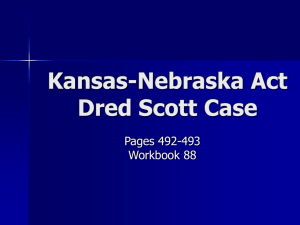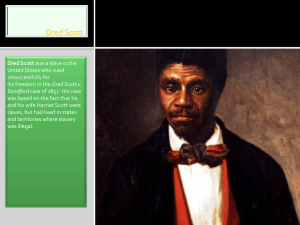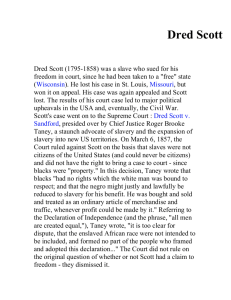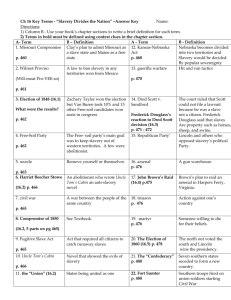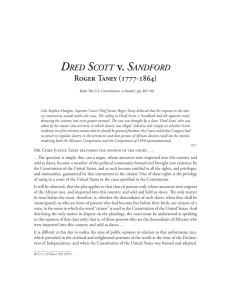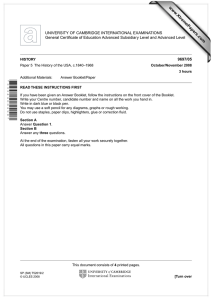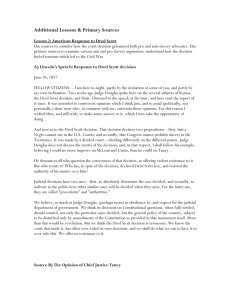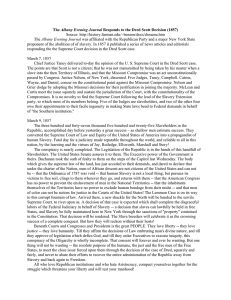Dred Scott v Sandford (1857)
advertisement
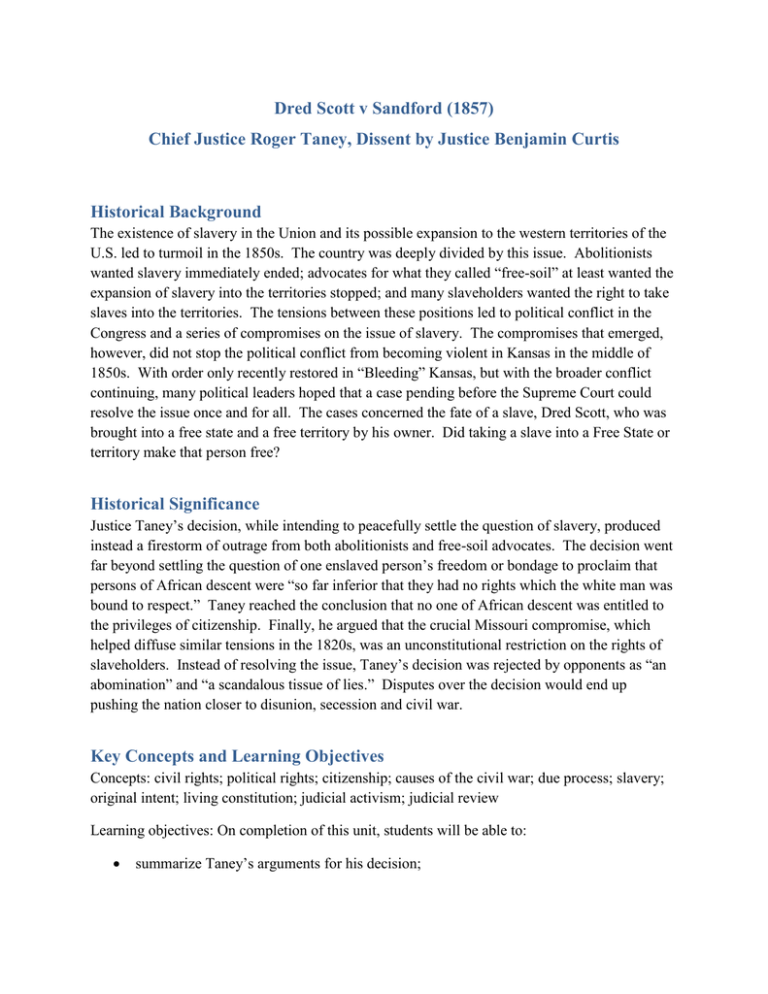
Dred Scott v Sandford (1857) Chief Justice Roger Taney, Dissent by Justice Benjamin Curtis Historical Background The existence of slavery in the Union and its possible expansion to the western territories of the U.S. led to turmoil in the 1850s. The country was deeply divided by this issue. Abolitionists wanted slavery immediately ended; advocates for what they called “free-soil” at least wanted the expansion of slavery into the territories stopped; and many slaveholders wanted the right to take slaves into the territories. The tensions between these positions led to political conflict in the Congress and a series of compromises on the issue of slavery. The compromises that emerged, however, did not stop the political conflict from becoming violent in Kansas in the middle of 1850s. With order only recently restored in “Bleeding” Kansas, but with the broader conflict continuing, many political leaders hoped that a case pending before the Supreme Court could resolve the issue once and for all. The cases concerned the fate of a slave, Dred Scott, who was brought into a free state and a free territory by his owner. Did taking a slave into a Free State or territory make that person free? Historical Significance Justice Taney’s decision, while intending to peacefully settle the question of slavery, produced instead a firestorm of outrage from both abolitionists and free-soil advocates. The decision went far beyond settling the question of one enslaved person’s freedom or bondage to proclaim that persons of African descent were “so far inferior that they had no rights which the white man was bound to respect.” Taney reached the conclusion that no one of African descent was entitled to the privileges of citizenship. Finally, he argued that the crucial Missouri compromise, which helped diffuse similar tensions in the 1820s, was an unconstitutional restriction on the rights of slaveholders. Instead of resolving the issue, Taney’s decision was rejected by opponents as “an abomination” and “a scandalous tissue of lies.” Disputes over the decision would end up pushing the nation closer to disunion, secession and civil war. Key Concepts and Learning Objectives Concepts: civil rights; political rights; citizenship; causes of the civil war; due process; slavery; original intent; living constitution; judicial activism; judicial review Learning objectives: On completion of this unit, students will be able to: summarize Taney’s arguments for his decision; describe the factual errors that Justice Curtis alleged were made by Justice Taney in making his decision and evaluate whether these factual errors make the decision invalid; define “civil rights” and “political rights”; determine whether the Constitution as it existed in 1857 grants rights to all citizens regardless of race. Questions to Explore Supreme Court Justice Scalia has argued that infamous cases like the Dred Scott Decision occur when the Supreme Court attempts to resolve questions that should be answered by the people and their representatives and not by the court. This problem is sometimes called “judicial activism.” Do you agree that the Supreme Court should attempt to steer clear of political controversy whenever it can? Why or why not? In Marbury v Madison Justice Marshall argued that it is the job of the court to decide what the law is. Abraham Lincoln respected this decision, yet he refused to accept the decision of Justice Taney in Dred Scott as settled law. Even if the case was wrongly decided, do presidents and candidates for president have an obligation to accept court decisions? The Constitution does not specifically use the word slave, enslaved, or slavery; however, several clauses in the Constitution implicitly address slavery, the most infamous of which being the “Three-Fifths Clause.” How does the presence of these clauses affect your view of the Justice Taney’s decision? The Dred Scott Decision provides a dramatic example of what happens when two party’s claims to rights radically conflict with one another. While we may view the “rights” of one side of the Dred Scott case with skepticism, there is no doubt that rights do genuinely conflict. How should a conflict between rights be resolved? Should this conflict be resolved with the help of government or by individuals? Are these conflicts best resolved locally or nationally? Are they best resolved by courts or by legislatures? Fully explain your responses to these questions. How should morality enter into governmental and judicial decisions? Is everything that is immoral also unconstitutional? Are there immoral or unjust laws that are not unconstitutional? Explain your answers.
